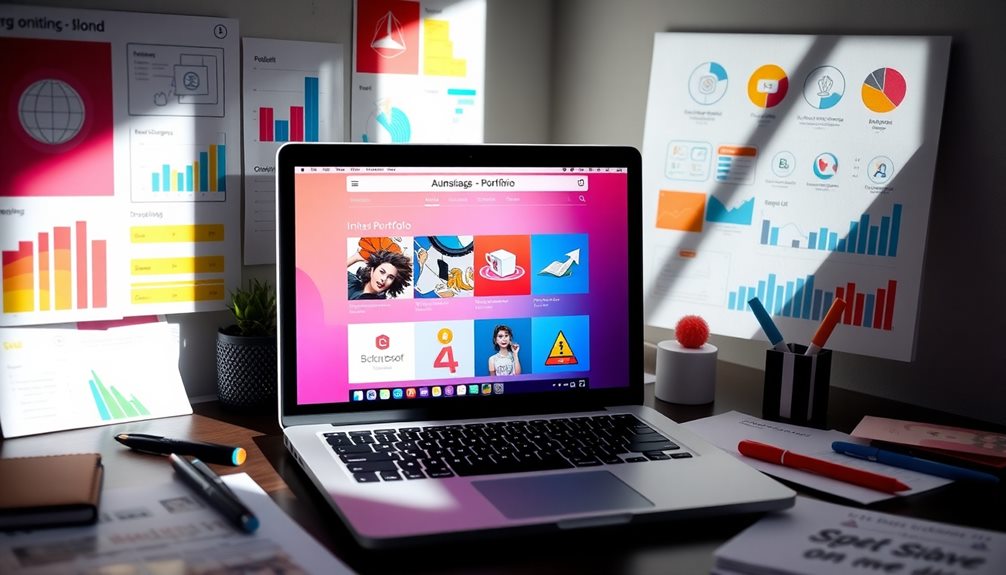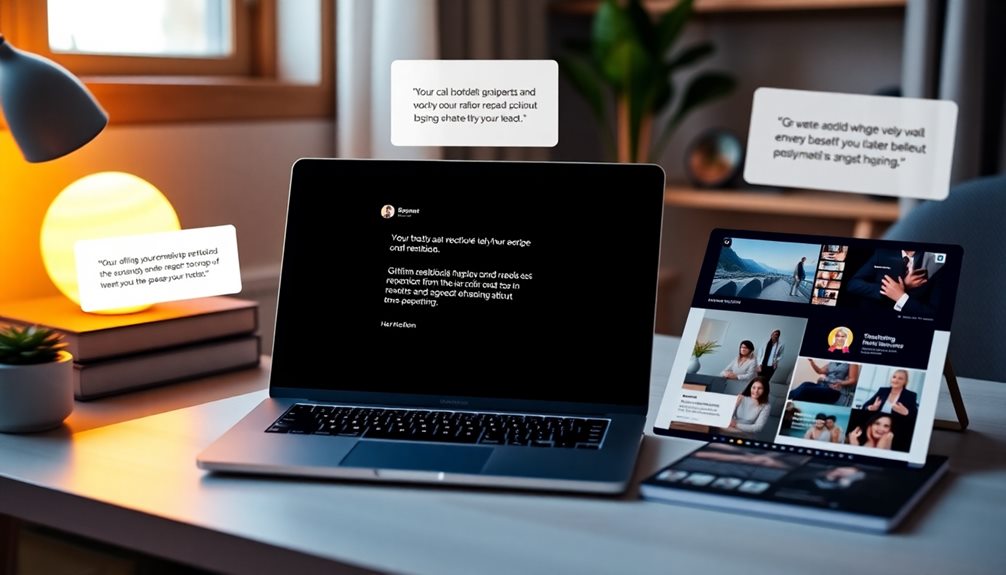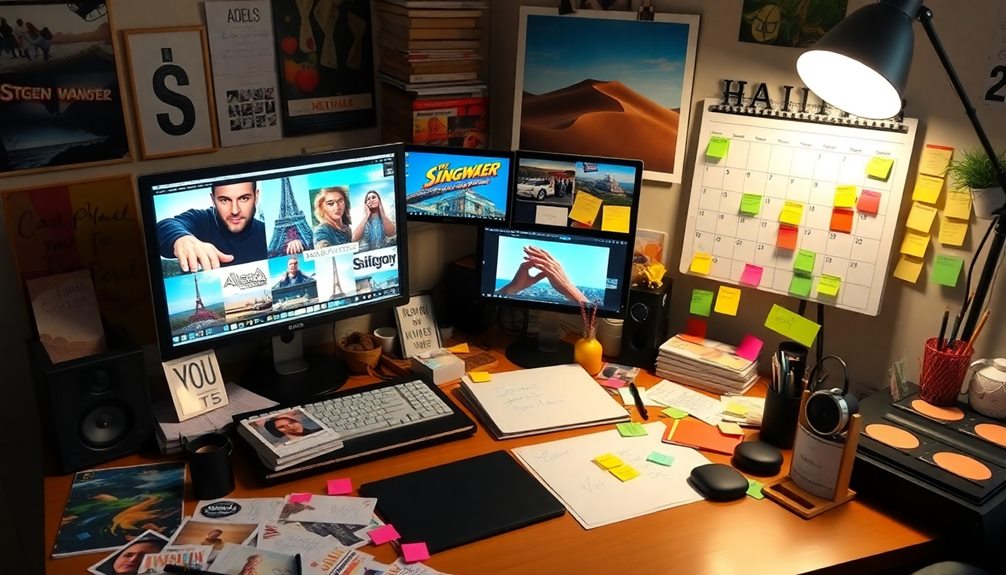To create a winning portfolio that lands remote work, start by understanding what your target audience needs. Choose high-quality work samples that showcase your skills and demonstrate your adaptability. Make sure your portfolio is visually appealing—use clean layouts, engaging colors, and clear typography to catch the eye. Incorporate testimonials to build credibility and highlight positive feedback. Finally, keep your portfolio fresh by updating it with new projects and skills. These steps not only set you apart, but they also entice potential employers to see the real value you bring. Stick around to uncover more insights!
Key Takeaways
- Curate high-quality work samples that showcase your skills and demonstrate your adaptability for remote work environments.
- Highlight your remote work experience and emphasize communication and self-motivation skills in your portfolio.
- Organize your portfolio for easy navigation, ensuring project descriptions are clear and concise.
- Incorporate testimonials and feedback to build credibility and showcase your collaborative spirit.
- Regularly update your portfolio with new projects and skills to reflect your growth and expertise.
Understand Your Target Audience

To create a winning portfolio for remote work, you first need to understand your target audience. Think about who you're trying to impress—employers, clients, or collaborators. Plunge into some audience research! What're their needs, preferences, and pain points? Knowing this helps you tailor your portfolio to resonate with them.
You might also consider how to immerse in a supportive community that can provide resources and insights into what potential employers are seeking.
Next, let's talk personal branding. Your portfolio isn't just a collection of your work; it's a reflection of you. Your brand should showcase your unique voice, skills, and values. Align your portfolio with what your audience is looking for. Use language and visuals that speak directly to them.
Imagine you're having a conversation with someone you want to connect with. What would you say? Highlight your strengths and experiences that relate to their needs. Show them how you can add value to their projects or company. When they see that you understand their world, they're more likely to feel a connection.
Select Relevant Work Samples

When it comes to selecting relevant work samples for your portfolio, focus is vital. You want to curate pieces that highlight your strengths and resonate with the type of remote work you're pursuing. Think quality over quantity here. It's better to showcase a few exceptional samples than to overwhelm potential employers with a massive collection that doesn't reflect your best work.
Consider the work variety you bring to the table. If you've tackled different projects—whether it's graphic design, writing, or project management—choose samples that demonstrate your versatility while still aligning with the positions you're applying for. This approach not only shows your range but also highlights your ability to adapt to different challenges, an essential skill in remote work environments.
As you sift through your past projects, ask yourself which ones truly represent your skills and passion. Pick those that tell a story about who you're as a professional. Remember, you're aiming to make a connection with your audience. Your work samples should evoke a sense of belonging, showcasing not just what you've done, but also how you can add value to their team.
Showcase Your Skills Effectively

A strong portfolio isn't just about showcasing your work; it's about effectively highlighting the skills that make you an ideal candidate for remote positions. When you think about your portfolio presentation, consider how each piece reflects your specific abilities. You want potential employers to see not just what you've done, but how well you can do it.
Skill demonstration is key. Choose samples that not only display your technical know-how but also your problem-solving skills and creativity.
For instance, if you're a graphic designer, include projects where you tackled unique challenges or collaborated with clients to bring their visions to life. This illustrates your adaptability and communication skills—qualities that are essential in a remote setting.
Don't forget to add context to your work. Briefly explain the project goals, your role, and the results. This narrative gives depth to your skill demonstration and shows how you can contribute to a team's success.
Remember, you're not just presenting work; you're telling a story about your professional journey.
Lastly, keep your portfolio organized and easy to navigate. A clear layout helps potential employers understand your skills quickly and efficiently. It fosters a sense of belonging, as they can see the value you'd bring to their team.
Design for Visual Appeal

Visual appeal plays a crucial role in making your portfolio stand out. When potential employers flip through your work, it's not just about what you've done; it's about how it makes them feel. By harnessing the principles of color theory, you can evoke emotions that resonate with your audience. Choose a color palette that reflects your personality and the type of work you do.
For instance, warm colors can create a sense of energy, while cool tones might communicate professionalism and calmness.
Don't forget about typography trends! The fonts you choose can greatly impact readability and the overall aesthetic of your portfolio. Opt for typefaces that are modern yet easy to read. A mix of bold headers paired with simple body text can create an engaging visual hierarchy, guiding your audience through your work seamlessly.
Remember, simplicity is key. A clean layout, with plenty of white space, allows your projects to breathe and shine. When your design is clutter-free, viewers can focus on what matters most—your incredible skills and creativity.
Lastly, don't hesitate to experiment! This is your portfolio, and it should reflect who you are. Whether you're drawn to minimalist designs or vibrant, eclectic styles, trust your instincts. When you feel confident in your design choices, that energy will translate into a portfolio that not only showcases your work but also invites others to connect with you. Embrace your unique style, and let your portfolio speak volumes!
Incorporate Testimonials and Feedback

Your portfolio isn't just about showcasing your work; it's also a platform to share what others think about your skills and contributions. Incorporating testimonials and feedback can be a game-changer in your quest for remote work. These endorsements not only highlight your strengths but also create a sense of trustworthiness, building credibility with potential employers.
Imagine a hiring manager scrolling through your portfolio, feeling reassured as they read glowing reviews from past clients or colleagues. These testimonials give them a glimpse into your work ethic, collaborative spirit, and problem-solving abilities. They serve as powerful social proof that you're not just talking the talk—you've walked the walk, and others have noticed.
Don't underestimate the impact of feedback, either. If you've received constructive criticism in the past, consider sharing how you adapted and grew from it. This shows resilience and a commitment to improvement, traits that remote employers highly value.
Plus, these testimonials can boost your confidence. When you see positive words reflecting your impact on others, it reinforces your self-belief. This newfound confidence can shine through in job applications and interviews, making you a more compelling candidate.
Keep It Updated and Relevant

Keeping your portfolio updated and relevant is essential in the fast-paced world of remote work. You want to showcase your best self and demonstrate that you're in tune with current trends and skills. Regularly engaging in content curation helps you gather and display your most impressive work, reflecting your growth and expertise.
Start by revisiting your portfolio every few months. Ask yourself what projects you've completed or skills you've acquired since your last update. If there are any new tools or techniques you've mastered, be sure to include them! This keeps your portfolio not only fresh but also appealing to potential employers who are looking for someone adaptable and forward-thinking.
Next, focus on portfolio organization. A well-structured portfolio makes it easy for hiring managers to navigate through your work. Group similar projects together, and use clear headings and descriptions. This way, your standout pieces shine, and your overall narrative is coherent.
Don't forget to highlight the impact of your work. Include metrics or outcomes where possible. This gives tangible evidence of your abilities and sets you apart from others.
Frequently Asked Questions
What Types of Projects Are Best for Remote Job Portfolios?
When you're building a portfolio for remote work, focus on showcasing a diverse range of projects.
Highlight freelancing gigs that demonstrate your adaptability and skills.
Include case studies that illustrate your problem-solving abilities and creativity.
Remember, potential employers love seeing variety! It reflects your versatility and makes you stand out.
How Can I Highlight Soft Skills in My Portfolio?
Highlighting soft skills in your portfolio is crucial! You can showcase adaptability by including examples where you've embraced change or learned quickly.
Emphasizing communication skills is just as significant; consider adding testimonials or case studies that demonstrate your ability to collaborate effectively.
Use visuals or infographic elements to make these skills stand out. Remember, your portfolio should reflect not just what you do, but who you're and how you connect with others.
Should I Include Personal Projects or Hobbies?
You might think personal projects or hobbies don't belong in a portfolio, but they absolutely do! Including side projects showcases your interests and skills, revealing your personality beyond just work experience.
They illustrate passion and initiative, making you relatable and memorable. Whether it's coding a personal app or designing art, these pursuits highlight your creativity and dedication.
Don't underestimate the value they bring; they can truly set you apart!
Is It Necessary to Include a Resume in My Portfolio?
Including a resume in your portfolio isn't strictly necessary, especially when you've got strong resume alternatives like a digital portfolio that showcases your skills. Think about what highlights your unique journey best. If your portfolio effectively conveys your experience and strengths, a traditional resume might feel redundant.
Instead, focus on creating engaging content that reflects who you're and what you can offer. You're building a connection, and that's what truly matters!
How Do I Handle Gaps in My Work History?
Ever wonder how to turn gaps in your work history into a strength? When explaining unemployment or addressing career breaks, focus on what you learned during that time. Highlight any skills you developed, volunteer work, or courses you took. This approach not only shows resilience but also your commitment to growth.
Conclusion
Just like a gardener nurtures a vibrant garden, you need to cultivate your portfolio. By understanding your audience and showcasing your best work, you're planting seeds that will blossom into remote job opportunities. Keep your garden updated, and let testimonials act as sunlight, helping your skills shine even brighter. Remember, every detail counts, so nurture your portfolio with care, and soon enough, you'll reap the rewards of your hard work in the form of fulfilling remote work.
